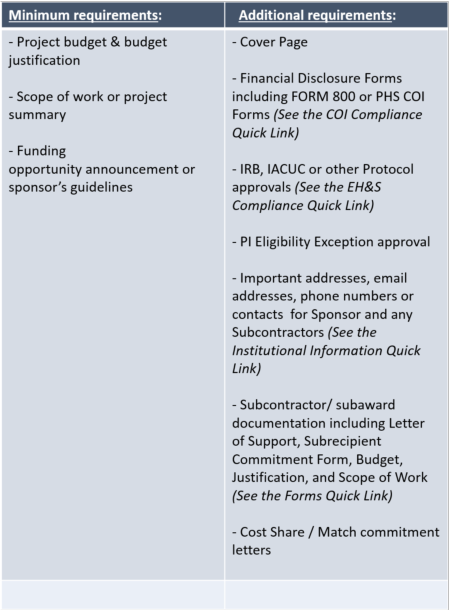Contracts & Grants: Proposals

ANR Employees Home / Administration / Business Operations / Contracts and Grants Home
Proposal Steps / Proposal Development / Find Funding Opportunities / Proposal Components / Budget Preparation / Proposal Resources

Proposal Steps

Step 1: Develop your ideas and contact OCG
Step 2: Plan and organize your proposal
Step 3: Research funding opportunities
Step 4: Draft your proposal
Step 5: Manage and coordinate the process
Step 6: Finalize, review, and submit the proposal
Other Considerations

- A great proposal is the outcome of effective planning and organization, but it is most important to begin the proposal process with a clear project concept and defined objectives. To start, consider writing responses to the following eight questions proposed by Robert Porter in ‘Six Critical Questions to Writing a Grant Proposal’.
1. What are you passionate about, i.e., where do you think you can make a uniquely significant contribution to your field?
2. What is the need, problem, or issue you want to address and why is it important?
3. If present knowledge or practice is inadequate, why do we need to know more and do better?
4. In what sense is your idea innovative, i.e., how does it differ from what has already been done?
5. What makes you think your idea or approach will have better outcomes?
6. What will your research contribute and who will benefit from it?
- With a project idea formulated, the Office of Contracts and Grants is prepared to assist you in planning and carrying out the next steps outlined. Please contact your assigned OCG analyst for assistance with a standard grant proposal, or the proposal development coordinator for eligible large grant proposals.

- There are several significant steps to grant-writing, including researching your idea, collecting preliminary data, recruiting potential partners, gaining internal and external support, targeting project resources, identifying funding opportunities, planning a strategy, writing, coordinating, obtaining approvals, and submitting the grant. Managing this process requires early planning and organization.
- Generate a list of required resources to conduct the project – data, facilities, equipment, institutional support, match for cost-sharing, outreach activities, evaluation assessments, or various sources of expertise.
- Having considered the resources required to conduct the project, write an abstract or concept paper providing an overview of the project, objectives, methods, and anticipated outcomes. This exercise will allow for further refinement and planning of the project. Share the summary with others that may be involved in the project or proposal development (peers, mentors, collaborators, community groups, industry partners, administrators, support staff, OCG). The goal is to involve these individuals or groups in the early planning of your proposal and incorporate feedback.
- With a proposal project planned and a team organized, turn your focus towards identifying the best funding sponsor and program fit for your project. OCG can guide you in identifying funding opportunities of interest.

- A sponsor seeks to fund projects that address the organization’s mission, vision, and strategic goals, while providing an impactful return on investment. To assess appropriate project ‘fit’ with a particular sponsor or funding opportunity, read strategic plans outlining the organization’s programmatic goals and future outlook, review abstracts of past awardees, or write the Program Officer providing an abstract or concept paper for discussion by phone or in-person meeting.
- When researching funding opportunities to support your project, consider the type of sponsor, sponsor’s mission, available programs, type of funding (project vs. conference), type of research (applied vs. basic), award size, application process, required proposal elements, eligibility (investigator and institutional), and timing of the funding opportunity deadline.

- Read the funding opportunity, request for proposals (RFP), or sponsor’s application guidelines carefully. Read once again and make notes.
- With the funding opportunity requirements in mind, take time to conceptualize and outline your project. Outline the proposal structure using the Sponsor’s review criteria, and incorporate section headings and keywords as presented within the RFP or sponsor’s guidelines.
- Throughout your draft continue to reflect upon the goals of the program and agency mission. Craft a persuasive argument for funding your project. Always adhere to the Sponsor’s requirements and fully address review criteria.
- Plan how much space to dedicate to each written section. For example, a proposal may require a more detailed and lengthy description of outreach activities over a description of the project team. Identify formatting requirements such as line spacing, page limits, font type and size. Consider also elements to enhance the flow of your writing such as subheadings, figures, tables, and photos, if permitted. Highlight dynamic features of the project such as partnerships by including letters of support as evidence of the commitments. Remember to include all required proposal components. For reference, organize required components into a checklist.
- Refer to the Sponsor’s budget requirements when establishing a project budget. Draft your budget by identifying costs for the overall project including collaborators, consultants, and other institutions. Detail expenses under categories for personnel (salaries & benefits), equipment, travel, participant support (trainee costs), material and supplies, publication costs, consultant services, computer services, and subawards/ subcontracts.
- For all subawards, note that a Sponsored Projects approved budget, justification, scope of work for the collaborator's portion of the project, and UC ANR Subrecipient Commitment Form is required for upload to the GTS record (see step 6 below). Identify funding restrictions and unallowable costs. These commonly include indirect costs, administrative salaries, capital equipment, and renovations. Ensure that you incorporate current institutional rates for employed staff, fringe benefits, and indirect costs.
- If not already determined, set aside sufficient time for writing. Write a first draft at least two to three months in advance of the deadline and share with colleagues.

- Utilize your team in the writing of the proposal. When working in team, establish which investigator will lead the project effort. Maintain a collaborative approach and keep all partners engaged in the proposal development process. Distribute duties and agree upon a proposal development schedule to complete the proposal well in advance of the submission deadline. Ensure that each proposal element has a targeted completion deadline. Aim to complete the budget and supporting documents (CV, biosketch, facilities description) early to allow you to focus on the technical narrative for the remainder of the process.
- Allow sufficient time for request and receipt of support letters as well as time for cost-share negotiation. Schedule in-person and teleconference project team meetings within an appropriate frequency.
- Team members should actively provide edits and comment on the proposal draft. Continue to solicit and incorporate feedback from team members. Decide upon a collaboration tool for document sharing, editing, and maintaining version control of proposal documents.
- Coordinate the timely collection of completed supporting documents from all collaborators.

- With conceptual contributions from all team members, begin to finalize each proposal section and component. Review the proposal in its entirety for completeness (have the review criteria been addressed; are all components included?), clarity (have you proofread for writing style and formatting?), and consistency with the Sponsor’s requirements.
- Once the proposal has been finalized, enter your project into the Grant Tracking System (GTS) and submit to ANR Reviewers.* Proposals for extramural support must be submitted through the OCG via the Grant Tracking System (GTS) at least 5 days prior to the submission deadline to allow for processing. This ensures that all extramurally funded projects conducted either by University employees or with the use of University resources or facilities have proper signature authority and comply with relevant University policies and guidelines. UC has put this policy in place to protect both the University and its academic employees.
Upload the following documentation into GTS:
*Click on the Submit to Reviewers button and your proposal will be routed to the reviewers you have identified and OCG for approval. You will be able to continue to work on your proposal and finalize the scope of work prior to submission to the sponsor.
- The OCG assists Cooperative Extension, Research and Extension Centers, and Statewide Programs in their efforts to secure extramural funding and promotes proper stewardship of those funds. When processing a proposal and the resulting award, the OCG reviews all documents to ensure that projects comply with relevant University policies and guidelines.
- Upon approval, OCG will submit the proposal to the sponsor on your behalf. For federal sponsors, submission is performed via Grants.gov. For non-Federal sponsors, upon approval from OCG, the Principal Investigator may submit the proposal directly to the funding sponsor. If the sponsor requires an “authorized official” or “institutional approval”, OCG will either sign and submit the proposal to the sponsor, or provide a signed cover page or letter to include within the submission.
- At the University of California all awards must be made to The Regents of the University of California, not to Cooperative Extension offices, Research and Extension Centers, Statewide Programs, schools, colleges, or 4-H Councils. No proposal seeking funding for extramural support for research, training, or public service programs or projects may be made in the name of the University without prior approval of The Regents or an authorized officer of the University. At the UC Division of Agriculture and Natural Resources (ANR), the Vice President–Agriculture and Natural Resources (VP ANR) has delegated such authority, within the limits set forth by The Regents, to the director and staff within the Office of Contracts and Grants (OCG).

Other Considerations

Proposals to a California State Agency
Model Contract Language for Agreements with the State of California
- To reduce inefficiency and to streamline contract negotiations, UCOP, CSU and the State Department of General Services established standardized terms for use in all new research, training or service agreements awarded after January 2016. A major change from prior practices is that the majority of the effort in securing a State award will be front loaded at the time of proposal. UC must provide the State with a proposal in advance of any award made. The proposal package consists of a cover sheet signed by the Office of Contracts and Grants, Scope of work (Schedule of Deliverables, List of Key Personnel, contact details, pre-existing data or works, Curriculum Vitae, Current and Pending Support), and Budget and Budget justification. Click Here for a copy of the proposal template.
OCG@ucanr.edu
Quick Links:
- FAQs
- Forms
- Budget - Indirect Costs
- Institutional Information
- Resources and Training Material
- COI Compliance
- EH&S Compliance
What are your top recommendations for applicants?
- When preparing the proposal, put yourself in the shoes of the reviewer. Focus on putting forth a well written proposal.
- Is the proposal written clearly, coherently, and concise.
- Are the project ideas presented well?
- Can the reader understand the significance, goals, methods, and anticipated outcomes?
- Consider the feasibility of the project. Is the project scope and approach appropriate for the funding opportunity. Have you proposed to take on too many or too few objectives in the project?
- Make a strong case for why your project is needed AND for why you and your team are most qualified to complete the project.
- We are here to help you succeed! Experience the benefits of working with the Office of Contracts and Grants.
- increases capacity for investigators to successfully attract extramural research funding and create relationships
- enables proactive response to sponsor’s solicitations
- access to emerging funding news and policy updates

